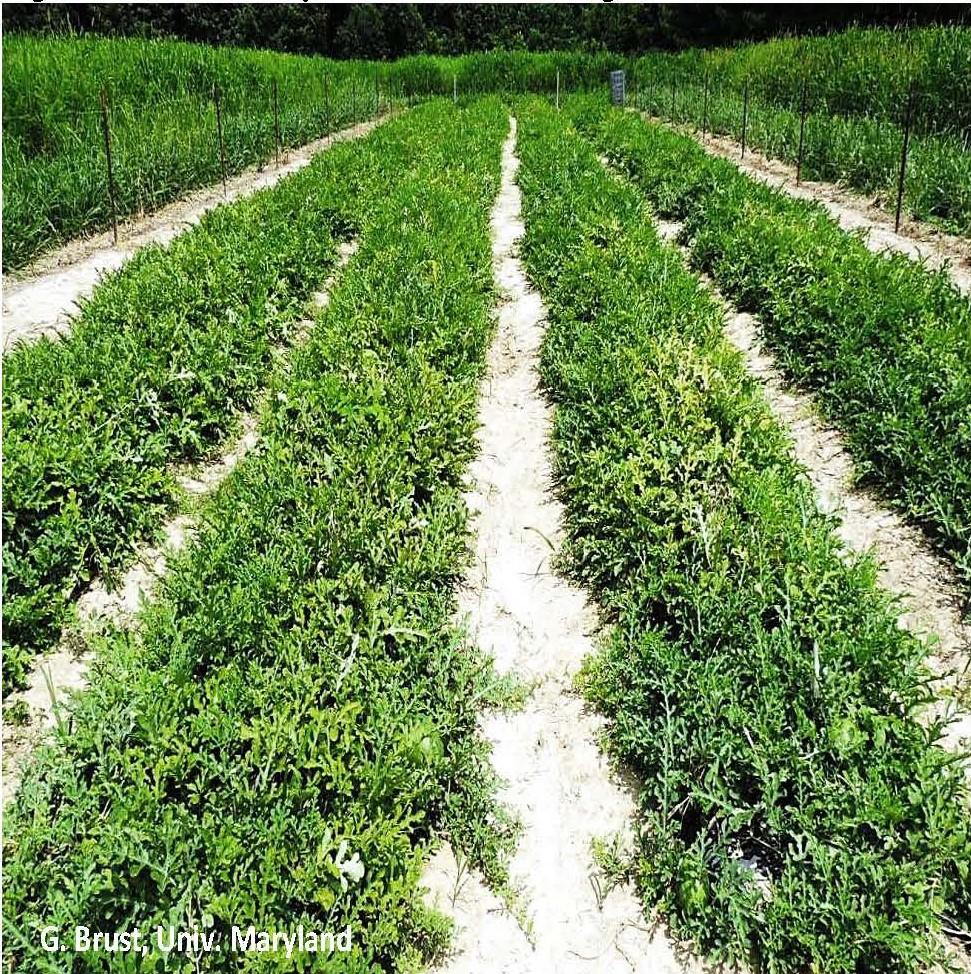Sulfur Deficiency in Corn and Watermelon
In the last week several sweet corn fields as well as some watermelon fields have been found with sulfur deficiencies (figs. 1 and 2). In sweet corn symptoms often appear as green leaves with light yellow or green striping on the newer leaves (fig. 1). In watermelon symptoms appear as a light green or light yellowing of the leaves of newer growth (fig. 2). Sulfur is vital to plant growth as it helps develop enzymes in plants. A deficiency in sulfur affects a plant’s protein synthesis, structure, and chlorophyll production (hence why plants turn a pale green or light yellow). Overall plant development and growth are stunted without enough sulfur. Newly transplanted vegetables often have a higher mortality rate than is typical.

In the last several years we have seen sulfur deficiencies fairly often in these two crops. I have not seen consistent sulfur deficiencies in other vegetable crops over this same time period. Organic matter supplies most of the sulfur to the crop, but sulfur must be mineralized to sulfate-S to be taken up by crop plants. Because mineralization is carried out by soil microorganisms, soil temperature and moisture primarily determine when and how much sulfur is made available to the crop. Excessively wet or very hot and dry conditions reduce microbial activity and reduce S availability from soil organic matter. For all the above reasons under field conditions sulfur deficiency and its symptoms can be highly variable. Although sandier soils are much more likely to be deficient in sulfur, I have seen sulfur deficient watermelon and sweet corn in soils with higher levels of clay or organic matter (2-4% OM).
There are other deficiencies that can cause striping or the general yellowing in sweet corn or watermelon respectively and only by conducting a tissue test can you be sure. Sulfur can be added to the crop in combination with several other nutrients such as ammonium or potassium and spray-grade ammonium sulfate is a good choice for foliar applications.
Return to Horticulture and Disease Topics
This article appears in Volume 15, Issue 6 of the Vegetable and Fruit News.
 English
English العربية
العربية Български
Български 简体中文
简体中文 繁體中文
繁體中文 Hrvatski
Hrvatski Čeština
Čeština Dansk
Dansk Nederlands
Nederlands Suomi
Suomi Français
Français Deutsch
Deutsch Ελληνικά
Ελληνικά हिन्दी
हिन्दी Italiano
Italiano 日本語
日本語 한국어
한국어 Norsk bokmål
Norsk bokmål Polski
Polski Português
Português Română
Română Русский
Русский Español
Español Svenska
Svenska Català
Català Filipino
Filipino עִבְרִית
עִבְרִית Bahasa Indonesia
Bahasa Indonesia Latviešu valoda
Latviešu valoda Lietuvių kalba
Lietuvių kalba Српски језик
Српски језик Slovenčina
Slovenčina Slovenščina
Slovenščina Українська
Українська Tiếng Việt
Tiếng Việt Shqip
Shqip Eesti
Eesti Galego
Galego Magyar
Magyar Maltese
Maltese ไทย
ไทย Türkçe
Türkçe فارسی
فارسی Afrikaans
Afrikaans Bahasa Melayu
Bahasa Melayu Kiswahili
Kiswahili Gaeilge
Gaeilge Cymraeg
Cymraeg Беларуская мова
Беларуская мова Íslenska
Íslenska Македонски јазик
Македонски јазик יידיש
יידיש Հայերեն
Հայերեն Azərbaycan dili
Azərbaycan dili Euskara
Euskara ქართული
ქართული Kreyol ayisyen
Kreyol ayisyen اردو
اردو বাংলা
বাংলা Bosanski
Bosanski Cebuano
Cebuano Esperanto
Esperanto ગુજરાતી
ગુજરાતી Harshen Hausa
Harshen Hausa Hmong
Hmong Igbo
Igbo Basa Jawa
Basa Jawa ಕನ್ನಡ
ಕನ್ನಡ ភាសាខ្មែរ
ភាសាខ្មែរ ພາສາລາວ
ພາສາລາວ Latin
Latin Te Reo Māori
Te Reo Māori मराठी
मराठी Монгол
Монгол नेपाली
नेपाली ਪੰਜਾਬੀ
ਪੰਜਾਬੀ Afsoomaali
Afsoomaali தமிழ்
தமிழ் తెలుగు
తెలుగు Yorùbá
Yorùbá Zulu
Zulu ဗမာစာ
ဗမာစာ Chichewa
Chichewa Қазақ тілі
Қазақ тілі Malagasy
Malagasy മലയാളം
മലയാളം සිංහල
සිංහල Sesotho
Sesotho Basa Sunda
Basa Sunda Тоҷикӣ
Тоҷикӣ O‘zbekcha
O‘zbekcha አማርኛ
አማርኛ Corsu
Corsu Ōlelo Hawaiʻi
Ōlelo Hawaiʻi كوردی
كوردی Кыргызча
Кыргызча Lëtzebuergesch
Lëtzebuergesch پښتو
پښتو Samoan
Samoan Gàidhlig
Gàidhlig Shona
Shona سنڌي
سنڌي Frysk
Frysk isiXhosa
isiXhosa